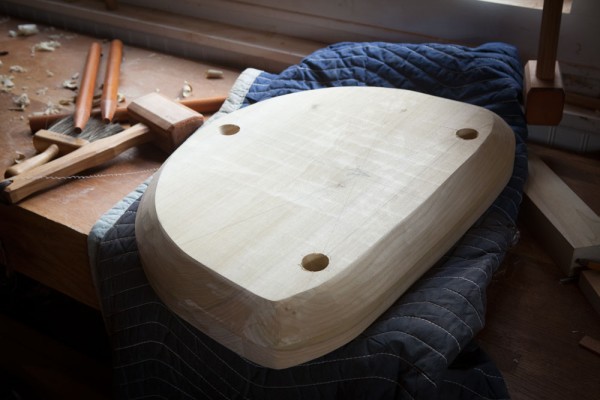We may receive a commission when you use our affiliate links. However, this does not impact our recommendations.
Some shop practices are so obvious that they hardly merit discussion. But every time I think that about some routine I have been taught, I am stunned by the blind spots of many of my students. (I am aware that I have blind spots, as well).
I’m always curious about shops that don’t have moving blankets lying around. How, I wonder, do they protect the work from becoming shop-worn? The few times I’ve had to work without a moving pad I was amazed at how damaged the piece can become by sitting on trestles, leaning against a wall or even being worked in a vise.
These dings can add an entire day of clean-up to the project.
When I build a project, I play a game with myself. How few times can I manipulate a piece of wood, assembly or finished carcase during the process? Once I’m done with a piece for the day, such as the chair seat above, I set it aside on a blanket and attempt to avoid touching it again until I absolutely have to.
And don’t get me started on how nuts it makes me to have to move assemblies just to make room for another operation.
This might sound like a stupid detail, but try it next time. I think you’ll be surprised how much crisper your work turns out.
— Christopher Schwarz
Here are some supplies and tools we find essential in our everyday work around the shop. We may receive a commission from sales referred by our links; however, we have carefully selected these products for their usefulness and quality.










This is one of those operations that many of us pick up by by example. In my case, my father had an electronics repair business when I was young (1970’s). I helped with moving TV’s (many were still black and white, all were quite heavy!) and general gopher stuff… He always had a few thick quilts or blankets on hand to keep them from damage. I have followed the practice ever since.
Thanks for the reminder!
Count me educated. This hadn’t occurred to me before. More than dings and nicks, I’m amazed at how grimy pieces get seemingly just by hanging out nearby. I know my hands can get a bit dirty when I’m working, but sheesh. And that’s not counting my many little “Roy Underhill’s” – all the small nicks and cuts that seem to appear on my hands and arms. There have been plenty of times I’ve decided I better take a break for a while and give my blood some time to clot up before working any more. It’s surprising how long it can take to plane or sand all those out of a piece.
I second pastorcrees above – thanks for being that guy for all of us!
Thanks a ton for stating the obvious Chris. I started woodworking about 2 1/2 years ago out of necessity to build a bunk bed that was less than $4,000 for my daughters that wouldn’t fall apart after a year. It was the beginning of something beautiful and I was lucky enough to find an older and wiser woodworking companion almost immediately to teach me some of the fundamentals and tricks of the trade but he too is a self taught wrangler of the beautiful grain. In short those of us who are without master, or even journeyman, tradesman close at hand really appreciate your commitment to being “that guy” for all us newbs. I had to re-plane some stock yesterday at the 11th hour for exactly the reasons you describe here and if I had been just a touch smarter I would have used a moving blanket or even a towel on my bench when affixing hinges and I would have saved the beautiful finish I worked up to with 5 steps of sanding. Thanks again for the wisdom!
I have a couple of HF moving blankets to cover my band and table saws. They come in real handy keeping the stuff protted from shop rash. I hate rashes…
LB
Jeff Miller called those dings and scratches “shop rash” in his Foundations of Better Woodworking book. I use that term a lot… because my $5 mexican blanket from the border in San Diego is not doing the job… too lumpy